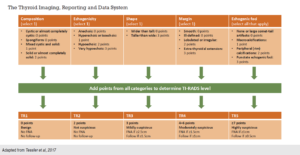Thyroid Nodules and Symptoms
Thyroid nodules are very common. They are more common in women, with some estimates of palpable thyroid nodules occurring in 6 per cent of the female population and 1.5 per cent of the male population.
Thyroid nodules are evaluated to determine:
• the likelihood of malignancy
• the likelihood that the nodule is the cause of symptoms.
While thyroid nodules are extremely common, thyroid cancer is a lot less common. Most patients with thyroid nodules do not have cancer. Ultrasound detects thyroid nodules in 19 to 67 per cent of the population, with 5 per cent being malignant. Thyroid nodules in children are less common and more likely to be cancerous when compared with thyroid nodules in adults. About 20 per cent of solid thyroid nodules in children are cancerous, compared with only 5 per cent of thyroid nodules in adults.
Thyroid Cancer
Thyroid cancer accounts for 1 per cent of all cancers in New Zealand, the incidence is 13 cases per 100,000 persons per year, and about one in 100 people develop thyroid cancer over the course of their lifetime. It is three times more common in women.
There are four main types of thyroid cancer:
• Papillary thyroid carcinoma is the most common type of thyroid cancer and has a tendency to spread to lymph nodes. With good treatment, it has an excellent prognosis. However, several variants of papillary thyroid carcinoma (tall cell, columnar cell, hob nail, diffuse sclerosing, solid, and telomerase reverse transcriptase promoter variants) have a worse prognosis.
• Follicular thyroid carcinoma is the second most common type of thyroid cancer. Even though it may spread to the lungs, it also has an excellent prognosis.
• Medullary thyroid carcinoma is less common. It sometimes runs in families and has an intermediate prognosis. Serum calcitonin is a very useful marker to diagnose medullary thyroid carcinoma and to assess response to treatment.
• Anaplastic thyroid carcinoma is a very aggressive thyroid carcinoma with very poor prognosis. Other less common types of thyroid cancer include primary lymphoma of the thyroid, squamous cell carcinoma of the thyroid and others.
Red-flag Symptoms
Most thyroid cancers only present as a thyroid nodule. Only the more advanced or aggressive thyroid cancers have red-flag symptoms.
Thyroid nodules associated with any of the following require urgent referral:
• rapid growth of the thyroid nodule/mass
• hoarse voice (from involvement of the recurrent laryngeal nerve)
• cervical lymphadenopathy.
Thyroid Nodule Symptoms
Generally, the larger the thyroid nodule, the more likely it is to cause compressive symptoms, such as a feeling of pressure, tightness or a lump in the neck. Thyroid nodules frequently do not cause any symptoms, particularly those less than 2cm in size. The position of a nodule within the thyroid may also contribute to symptoms.
Some experts believe nodules in the posterior part of the thyroid are more likely to cause a globus-type feeling of something in the throat than a similar sized nodule in the anterior part of the thyroid. If a nodule gets very large, it may cause compression of the trachea, resulting in shortness of breath on exertion and when lying down.
Large thyroid nodules may also cause superior vena cava syndrome, with restriction of venous drainage from the head and neck. This is most noticeable when the arms are raised in such activities as hanging out the washing. Patients may go red in the face when doing such activities (positive Pemberton sign).
*The second part of this article will be included in the next newsletter.


